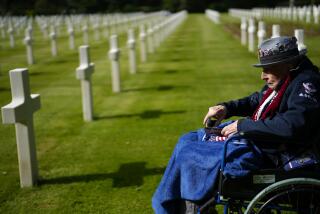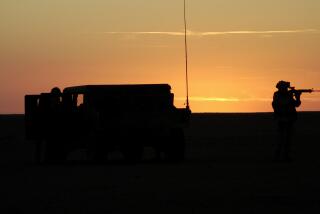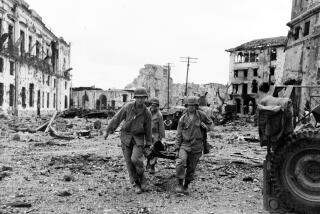One Marine’s Return to Bloody Beach at Tarawa : Assemblyman Ferguson to Relive Landing--50 Years Later
On Saturday, Gil Ferguson of Newport Beach, 70, will stand on the white sands of the tiny island of Tarawa, a dot just off the Equator, barely inhabited and blanketed with relentless heat. He will walk the tranquil shoreline, and remember.
It was Nov. 20, 1943--50 years ago to the day, and also a Saturday--that Ferguson, facing a hail of Japanese gunfire, landed upon that shore with the first wave of invading U.S. Marines. The resulting engagement became the bloodiest battle in Marine Corps history, with 3,000 Americans killed or wounded within hours.
Ferguson is convinced that he can find the spot where shrapnel from a hand grenade ripped into his right leg and the explosion knocked him unconscious. And the place where he crossed the enemy’s defensive line of concrete and coconut tree logs. And the place where he and about nine others hid in a bunker, after being cut off from their units.
Ferguson, a Republican, politically conservative, is now a state assemblyman, representing the 70th District--Newport Beach, Irvine and some surrounding neighborhoods. When he learned that a group of Marines and journalists were planning a 50th anniversary reunion trip to Tarawa, he knew he had to go.
“I really can’t explain it,” he says. “I’m determined to find where I was wounded. I know exactly where it was because we’d come in off a point. I just want to go there and let it all come back. I suppose all of us are inexorably tied to our youth. Tarawa is where I spent my youth.”
He has not seen the island--part of what were then called the Gilbert Islands, and about the size of Balboa Island, he says--since World War II. Tarawa lacks even fresh water for its more than 20,000 residents, and it’s so out of the way from anywhere else--about 2,500 miles southwest of Hawaii--that few have occasion to go there. But Ferguson has been a little amazed over the years at how so much of it remains with him.
It wasn’t his only battle. After Tarawa, he fought in other World War II campaigns. As a career Marine, he was also on the front lines in Korea and Vietnam.
“I learned not to internalize, so I hardly remember details of any battles I’ve been in,” he says, “except for Tarawa. Tarawa, I can tell you what I did every minute of every hour. Maybe because what happened was so ferocious. I was so naive, I allowed it to impress me.”
*
Ferguson was barely out of his teens when his unit, following hours of naval air and artillery bombardment, stormed ashore on the heavily fortified island in one of the amphibious tanklike carriers that, along with swarms of landing craft, ferried the Marines from troop transport ships. Ferguson can still feel that battle anticipation.
The Marines had spent their time in the amphibious carriers and landing craft fighting seasickness and clutching their M-1 rifles. Fear wasn’t the emotion they felt; it was “an excitement, a nervousness. There was just this tremendously high energy level,” he recalls. “I remember we kept rechecking to make sure our rifles were really loaded. And when a wave would hit us, we’d keep reloading to make sure they hadn’t gotten wet.”
He was lucky to be among the first to wade ashore, he says, because the Marines had misjudged the depth of the island’s rugged coral reef, and only the amphibious carriers could cross it. Many Marines in deeper-draft landing craft drowned at sea when their vessels could not cross the reef and foundered.
Ferguson has mentally replayed his landing many times:
“We thought maybe the air power had destroyed them. But as we approached (the beach), two artillery rounds flew over our heads. We looked at each other in absolute silence.
“When we reached the beach, our sergeant jumped up and yelled, ‘Everybody out!’ And right then he got hit. Blood shot from his neck and splattered every single one of us. It was a shocking introduction to war.”
It was daylight, but Ferguson and his fellow Marines could barely see in front of them for all the smoke of battle. After 30 minutes of exchanging gunfire with a nearby Japanese position, Ferguson says, he actually saw a hand snaking out of a pillbox and throwing the grenade that felled him.
When he regained consciousness, he mistakenly thought his unit had gone ahead without him. He started forward, and stumbled into the dead all around him. He came across one body: that of the corporal who had led them in prayer before battle that morning.
Ferguson made it across the island amid the gunfire and ended up in a bunker with nine other Marines.
“Our energy level was so high, it wasn’t until much later that I realized my leg was in pain,” he says.
In three days of battle, the Americans finally reached and captured the airfield that had provided a strategic base for the Japanese in the Pacific. Nearly all of the 5,000 Japanese defenders of the island were killed; they had refused to surrender. Three-fourths of the Marines were killed or wounded.
“It was just a horrid, terrible battle,” he says. “It was like being in the middle of an awful barroom fight that went on for three days.”
Many who have chronicled the war in the Pacific have questioned whether the gains achieved by taking Tarawa were worth the high death toll.
“Tarawa had been a costly fight. But it taught the Allies some valuable lessons,” Trevor N. Dupuy writes in his “Military History of World War II.”
Ferguson agrees: “We learned that you don’t send in your troops without better bombardment from the air leading the way.”
Since that battle 50 years ago, Ferguson has had one reunion he had never expected. By sheer happenstance, at another military base years later, he came across the sergeant from his landing craft. “I thought for sure he had died--he was hit so bad,” Ferguson says.
*
Over the years, Ferguson has learned that the Tarawa natives left much of the Japanese artillery in place. Many of the bunkers and pillboxes also remain. The single airstrip that was the focal point of the Tarawa battle is still there. It is where Ferguson and the others will land this week for their somber reunion ceremonies.
He cannot remember any of the other veterans whose names appear on the list of those going to the reunion, Ferguson says. But he knows what an experience it will be if one of them turns out to be someone from his landing craft, or someone who had shared the bunker with him.
Ferguson had three brothers who also fought in World War II. One was killed. The other two do not share his compelling need to return to the past. But Ferguson says his wife and four grown children understand, and are supportive.
He says he wants to do more than just remember. He wants to do something for Tarawa. He will be joined by a close friend, Newport Beach developer Richard Sewell, who sometimes fishes off an island not too many hundreds of miles away. Between them, Ferguson says, they hope to do something to help Tarawa’s natives get a better water system, anything to help improve their lives.
But Ferguson will also relive the American assault for his friend. He will explain the Japanese defense system, show him the pillboxes that were the source of the enemy grenades and withering machine-gun fire. He will point out where the wounded lay on the flat sand at night, crying out in pain for help. And Ferguson will search for the ground behind that defensive line of coconut tree logs, long since gone, where he nearly died.
“I guess I’ll just stand on that spot and thank God that I managed to fight in three wars and somehow still came out alive.”
More to Read
Sign up for Essential California
The most important California stories and recommendations in your inbox every morning.
You may occasionally receive promotional content from the Los Angeles Times.









